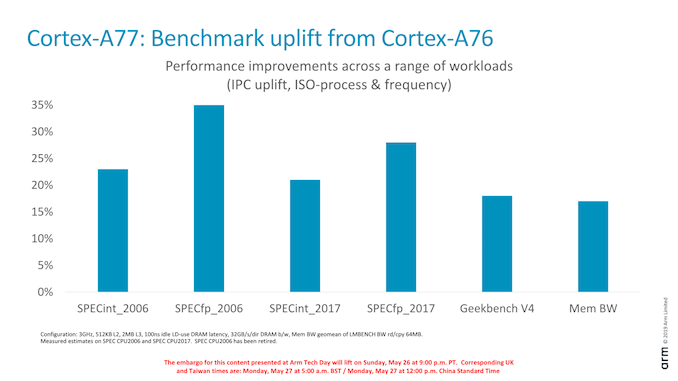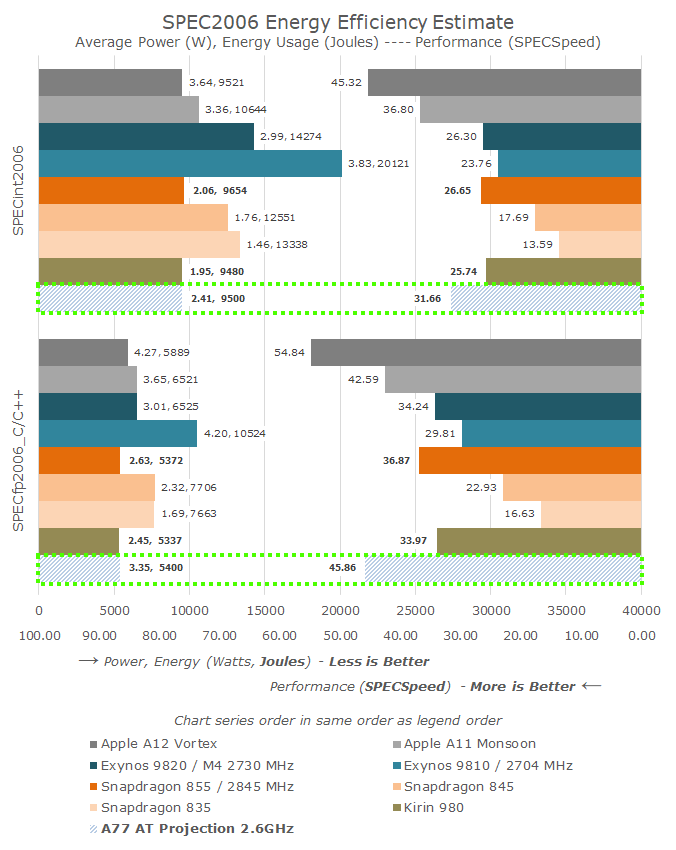Arm's New Cortex-A77 CPU Micro-architecture: Evolving Performance
by Andrei Frumusanu on May 27, 2019 12:01 AM ESTPerformance Targets: 20-35% Better IPC
The Cortex-A77 saw some interesting microarchitectural changes that promise to increase performance. The question now remains where exactly the targeted performance gains will end up at?
In terms of published performance improvements, Arm opted to stay with SPEC2006, 2017, GeekBench4 and LMBench memory bandwidth. Our focus here will be on SPEC2006 as it’s still the most relevant benchmark among the set for mobile.
On SPECint2006, the A77 promises around a 23% IPC increase, while SPECfp2006 claims a more staggering 35% boost. The 23% increase for integer workloads was more or less in line with what we expected of the CPU core, however the 30-35% increase for FP workloads I must admit came as quite a surprise, particularly since we haven’t seen any significant changes on the FP execution units of the core. An explanation here would be that SPEC’s FP test suite is more memory intensive than the integer suite, and the Cortex-A77’s various microarchitectural improvements would be more visible in these workloads.
Last year I had made performance and efficiency projections for the A76 at two frequency points, and I ended up being quite close to where the Kirin 980 and Snapdragon 855 ended up landing. For the Cortex-A77, things should be a lot more straightforward to project as we won’t see major process node changes in the next generation 7nm SoCs.
Baselining on the current results of the Kirin 980, I simply extrapolated performance based on the published IPC increases for a theoretical 2.6GHz Cortex-A77 SoC. It’s to be noted that although Arm this year again talks about 3GHz target frequencies for the A77, I’m not expecting vendors to quite reach this frequency in upcoming SoCs, thus the 2.6GHz projection.
In terms of performance, the integer suite would see some solid improvement, however the floating-point results are a lot more interesting. If correct, the A77 would exceed the FP performance of Apple’s A11 and make for quite a big generational push even though we’re not expecting big process node improvements. It’s to be noted though that the A77 will have to compete with Apple’s A13 later this year as well as next-gen M5 cores from Samsung.
Arm promises energy efficiency of the A77 will remain the same as current-gen A76 SoCs. Thus at peak performance, both CPU cores would use the same amount of energy to complete a set workload. The increased performance of the A77 would however have one drawback: Increased power usage, linear with the increased performance figures. This latter increased power usage would seemingly reach levels where running more than two cores at peak frequency would be more problematic in a mobile SoC. Luckily, most vendors have moved on from 4 full-speed big cores to 2+2 or 3+1 designs where there’s only one or two high-power big cores.
It’s to be noted although we’re talking about big cores here, the A77 is said to be only 17% bigger than the A76 – still significantly smaller than the next best microarchitecture from the competition.
End Remarks
Overall the Cortex-A77 announcement today isn’t quite as big of a change as what we saw last year with the A76, nor is it as big a change as today’s new announcement of Arm’s new Valhall GPU architecture and G77 GPU IP.
However what Arm managed to achieve with the A77 is a continued execution of their roadmap, which is extremely important in the competitive landscape. The A76 delivered on all of Arm’s promises and ended up being an extremely performant core, all while remaining astonishingly efficient as well as having a clear density lead over the competition. In this regard, Arm’s major clients are still heavily focusing on having the best PPA in their products, and Arm delivers in this regard.
The one big surprise about the A77 is that its floating point performance boost of 30-35% is quite a lot higher than I had expected of the core, and in the mobile space, web-browsing is the killer-app that happens to be floating point heavy, so I’m looking forward how future SoCs with the A77 will be able to perform.
But even in the integer workloads a 20-25% IPC gain is absolutely marvellous improvement, and we do trust Arm to be able to maintain energy efficiency of the A76. Power will go up slightly, but I think the industry has shown that mobile devices today handle at least two higher power cores properly, so future SoCs should continue with big+middle+little CPU configurations.
Coming A77 SoCs from vendors are expected to still be 7nm – Qualcomm and HiSilicon are the two obvious leading customers that would adopt the core and I’m expecting similar timeframes as last generation’s chipsets. For now- Arm’s delivering on their promised 20-25% yearly CAGR and we believe this to continue for the foreseeable next few generations.












108 Comments
View All Comments
Retycint - Wednesday, May 29, 2019 - link
This isn't 2012 anymore. A 30% better performance (for instance) isn't going to lead to any real world differences, especially given the fact that most consumers use their phones as a camera/social media machinejackthepumpkinking6sic6 - Thursday, May 30, 2019 - link
How foolish to actually sit there and act as if that's the only option. First of not only are those not the only high end option but they clearly said lower cost. Meaning any segment. Even mid and low range. Use your brain before commenting.Not to mention that despite being similarly priced and having insignificantly different benchmark scores those devices are overall better and more worthy the price.... Though none are worthy of such prices. Just some are more worth it than others.
alysdexia - Monday, December 30, 2019 - link
performance -> speedAnandtech never explain how they get their power figures; I saw one mention of regression testing under the iPhone XS review but still no work. The figures look more like shared power or peak power than average CPU power as they conflict with general runtime or battery drain tests which suggest 2 watts sustained; I recently took Notebookcheck's loads of power figures to revise my list of the thriftiest CPUs where I found the equivalent TDP somewhere between the load and idles and implied screen, GPU, and memory powers; another way to estimate is to subtract the nonCPU from the power adapter rating which for iPhones is 5W, screen 1W to 2W. I had to throw out Anandtech's SPEC2006 powers.
Androids do not get thriftier chips; iPhones idle better than the average (Use the comparison tool under any Notebookcheck review) and their huge cache seems to save power. (iPhone 11 has 33MB vs. S10 5MB. This makes A13 over 4fold as good as 9820.)
W CPU/(CPU+GPU): select core–unit CPUmark [mobile/60] (Gn/s) {Mp/s/10; LZMA-D Mp/s/10}, Geekbench 5, UserBenchmark Int 2019 Dec: /W, /$
~1·2: Cortex-A77 A13, [11145] (29·3), 1330–3422, : [~9288], ; , ; , Lightning-Thunder
~2: Cortex-A76 A12X, [12591] (45), 1114–4608, : [~6296], ; ~2304, ; , Vortex-Tempest
~1·7: Cortex-A76 A12, [8006] (27), 1111–2869, : [~4709], ; ~1688, ; , Vortex-Tempest
~1·5: Cortex-A73 A10X, [6475] (19·5), 832–2274, : [~4317], ; ~1516, ; , Hurricane-Zephyr
~2: Cortex-A75 A11, [7267] (26·3), 919–2372, : [~3634], ; ~1186, ; , Monsoon-Mistral
~2: Cortex-A76-A55 485, [4429], 767–2715, : [~2214], ; ~1358, ; , Kryo
·003: Cortex-M0+ 1.8V 64MHz, {9}, , : {2870}, ; , ; ,
~2: Cortex-A75-A55-M4 9820, [4298], 762–2148, : [~2149], ; ~1074, ; , Exynos
~2: Cortex-A76-A55 990, [4078], 761–2861, : [~2039], ; ~1431, ; , Kirin
~2·2: Cortex-A73 A10, [4748] (12·6), 744–1333, : [~1976], ; ~606, ; , Hurricane-Zephyr
·012: M14K, {29}, , : {2500}, ; , ; ,
1·7: Cortex-A73-A53 280, [<3031] (), 387–1448, : [<1783], ; 852, ; , Kryo
2? ~(40/53): Cortex-A53 625, [2604], 260–773, : [1725?], ; 387?, ; , Apollo
2·5: Cortex-A75-A55 385, [3940] (), 514–2191, : [1576], ; 876, ; , Kryo
~2: Cortex-A53-M2 8895, [>3031] (), 373–1497, : [>1516], ; ~749, ; , Exynos
~2: Cortex-A57-A53 A9X, [3000] (10·5), 3097–5284, : [~1500], ; , ; , Twister
~1·5: Cortex-A53-A57 A9, [2200] (12·7), , : [~1467], ; , ; , Twister
·001: Cortex-M0+ SAM L21 12MHz, {2}, : {1929}, ; , ; ,
·0033: Cortex-M0 1.8V 50MHz, {6}, , : {1920}, ; , ; ,
·09: SH-X4, {172}, , : {1856}, ; , ; , SH-X4
·000825: Cortex-M4 STM32L412xx 8MHz, {15}, , : {1852}, ; , ; ,
·013: Cortex-M3, {24}, , : {1790}, ; , ; ,
·15: 24K, {235}, , : {1600}, ; , ; ,
~1·8: Cortex-A57-A53 A8X, [2032] (10·6), , : [~1129], ; , ; , Typhoon
·15: 34K, {232}, , : {1455}, ; , ; ,
alysdexia - Monday, December 30, 2019 - link
dammit can't edit:15 ~3/5: i5-1035G7, : ~, Ice Lake
15 ~11/14: i7-10710U, 13107: ~1112, 30 Comet Lake
15 ~16/19: i5-10210U, : ~, Comet Lake
Findecanor - Monday, May 27, 2019 - link
I wonder what the difference would be if ARM removed AArch32 support like Apple did.RSAUser - Tuesday, May 28, 2019 - link
We might see it with next gen as Google is dropping 32bit app support on the Play Store. If there is a performance advantage/cost or power saving, they'll probably implement it.beginner99 - Tuesday, May 28, 2019 - link
However with android you also get the performance at half the price. What these charts don't show is the actual size of the chip and apple SOCs are large and hence more expensive.michael2k - Thursday, May 30, 2019 - link
ARM isn't competing with Apple and doesn't need to compete with Apple.ARM licenses out it's implementation to those who also cannot compete with Apple.
You get the benefit, as compensation for lower performance, of a cheaper phone.
If you really want something that is as high performance you're going to have to buy from a company willing to invest the money into designing such a CPU, and that requires a different budget than licensing ARM's SoC/CPU designs.
Meteor2 - Monday, June 3, 2019 - link
ARM's cores matched Apple for efficiency with A76 (a breakthrough design), alongside sufficient performance.With large increases with IPC per generation we're seeing from ARM, I don't think it will be long before the absolute performance gap is closed either -- if SoC manufacturers choose to equal Apple's peak power draw. They may well not, and nobody will mind.
markiz - Tuesday, June 4, 2019 - link
Out of curiosity, what is it that you want to do on your phone that you feel is too slow on e.g. S855 phone?